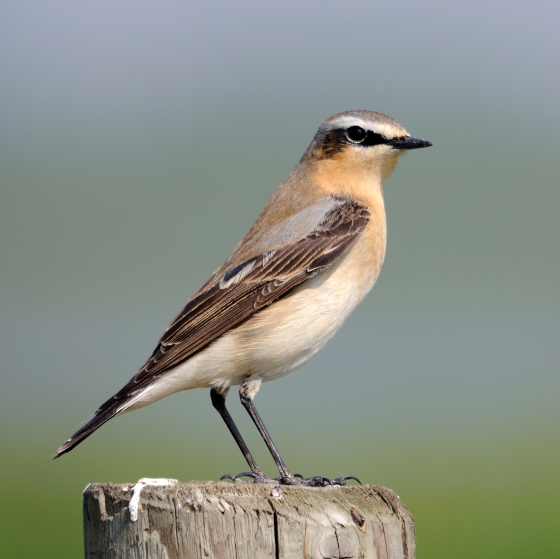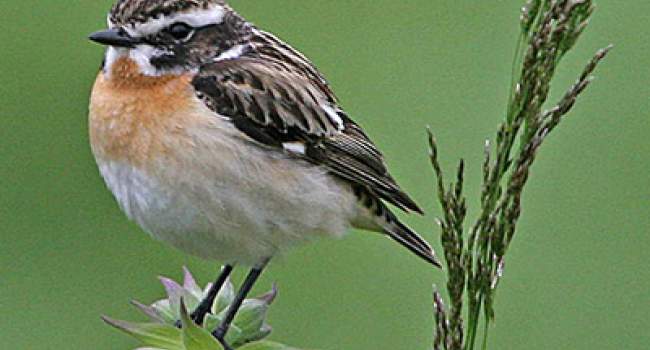Wheatear
Oenanthe oenanthe (Linnaeus, 1758)
W.
 WHEAT
WHEAT  11460
11460

Family: Passeriformes > Muscicapidae

A bird of open country and our wilder places during the summer months, the Wheatear can be seen across Britain & Ireland.
The size of a Robin, the bandit-masked male and sandy brown female can be seen in Britain & Ireland from early March to late October). The Wheatear is a long-distance migrant, heading for Africa in the winter. During spring and autumn, birds making their way to and from Greenland and Alaska pass through the UK. These birds, which are larger and brighter than the birds that remain here to breed, undertake one of the longest migrations of any songbird, with some flying non-stop across the Atlantic to northern Spain and then on to West Africa.
UK Wheatear numbers have fluctuated in recent decades. There has been a moderate decline since 2010, placing the species on the UK Amber List. Although they can be spotted throughout Britain & Ireland on passage, Wheatears primarily breed in the north and west of each, including on Scotland's farthest flung islands.
Exploring the trends for Wheatear
Our Trends Explorer will also give you the latest insight into how the UK's Wheatear population is changing.
trends explorerIdentification
Wheatear identification is often straightforward. The following article may help when identifying Wheatear.
Identifying Chats

This identification video looks at Whinchat, Stonechat and Wheatear. These three birds are not too difficult to separate in breeding male plumage, but a lot harder in female and juvenile. Check out our tips to help here.
SONGS AND CALLS
Listen to example recordings of the main vocalisations of Wheatear, provided by xeno-canto contributors.
Call
Song
Develop your bird ID skills with our training courses
Our interactive online courses are a great way to develop your bird identification skills, whether you're new to the hobby or a competent birder looking to hone your abilities.
Browse training coursesStatus and Trends
Population size and trends and patterns of distribution based on BTO surveys and atlases with data collected by BTO volunteers.
CONSERVATION STATUS
This species can be found on the following statutory and conservation listings and schedules.
POPULATION CHANGE
Although it is a common breeding species in many upland areas, the Wheatear was not monitored at the UK scale until the BBS began in 1994. Gibbons et al. (1993) had by then identified range contractions from lowland Britain since 1968-72. Further loss of range, especially in lowland England, had been recorded by 2008-11 (Balmer et al. 2013). BBS trends show wide fluctuations, with little indication of directional change, although a moderate and ongoing decline since around 2010 has triggered alerts in England, Scotland and Wales and for the UK as a whole. Previous estimates of UK population have been revised strongly upward, based on BBS distance-sampling data (Gillings et al. 2007).
There has been a decline across Europe since 1980 (PECBMS: PECBMS 2020a>). Following widespread declines during the 1990s, the European status of this species was no longer considered 'secure' (BirdLife International 2004). Accordingly, the species was moved from the green to the amber list in the UK in 2009 (Eaton et al. 2009). Following a review of its European status, however, Wheatear returned to the UK green list in 2015 (Eaton et al. 2015). Studies of remnant populations in the Netherlands indicate that conservation action may need to be site specific (van Oosten et al. 2015).
In 2012 and 2013, BTO conducted a Wales Chat Survey for Whinchats, Stonechats and Wheatears. Breeding Wheatears were associated with grassland and rocky outcrops, and the population estimate for Wales was 13,759 pairs (95% confidence intervals: 7,153-25,861); however this estimate was considered high in comparison with previous Welsh population estimates, and dedicated survey methodology may be required for accurate assessment of this species' population (Henderson et al. 2017).
| UK breeding population |
-32% decrease (1995–2020) 
|
Exploring the trends for Wheatear
Our Trends Explorer will also give you the latest insight into how the UK's Wheatear population is changing.
trends explorerDISTRIBUTION
Wheatears are summer visitors to the uplands and coasts of north and west Britain, and to the northern and western counties of Ireland. Elsewhere they are localised, with small outposts in Ireland on the Antrim coast and in the Wicklow Mountains, and in Britain on Salisbury Plain and in a handful of coastal squares in southeast England. Densities are highest throughout the uplands and near the coast. Many Scottish islands also support high densities, possibly because on many, most of the land is near the coast.
Occupied 10-km squares in UK
| No. occupied in breeding season | 1704 |
| % occupied in breeding season | 56 |
| No. occupied in winter | 125 |
| % occupied in winter | 4.1 |
European Distribution Map
European Breeding Bird Atlas 2
Breeding Season Habitats
| Most frequent in |
Moorland 
|
Relative frequency by habitat
Relative occurrence in different habitat types during the breeding season.

DISTRIBUTION CHANGE
Since the 1970s there has been a 14% range contraction in Britain and a 24% contraction in Ireland. Gradaul losses have led to the disappearance of distinct breeding areas, including the southeast coast of Ireland, Breckland and the southern English heaths and downland.
Change in occupied 10-km squares in the UK
| % change in range in breeding season (1968–72 to 2008–11) | -12.7% |
| % change in range in winter (1981–84 to 2007–11) | --6.8% |
SEASONALITY
Wheatear is a summer visitor, with first birds arriving in mid March; migration peaks in late April./early May but migrants can continue to arrive, particularly those bound for Greenland. Autumn migration is mostly in August and September but late birds can be seen into early November.

Movement
Information about movement and migration based on online bird portals (e.g. BirdTrack), Ringing schemes and tracking studies.
An overview of year-round movements for the whole of Europe can be seen on the EuroBirdPortal viewer.
RINGING RECOVERIES
View a summary of recoveries in the Online Ringing Report.
Foreign locations of birds ringed or recovered in Britain & Ireland

Biology
Lifecycle and body size information about Wheatear, including statistics on nesting, eggs and lifespan based on BTO ringing and nest recording data.
PRODUCTIVITY & NESTING
Exploring the trends for Wheatear
Our Trends Explorer will also give you the latest insight into how the UK's Wheatear population is changing.
trends explorerSURVIVAL & LONGEVITY
View number ringed each year in the Online Ringing Report
Maximum Age from Ringing 
|
8 years 3 months 16 days (set in 2010) 
|
Typical Lifespan 
|
2 years with breeding typically at 1 year |
Adult Survival 
|
0.46 (Male: 0.5±0.02 Female: 0.42±0.02)  
|
Exploring the trends for Wheatear
Our Trends Explorer will also give you the latest insight into how the UK's Wheatear population is changing.
trends explorerBIOMETRICS
Wing Length 
|
Adults | 99.9±4.7 | Range 93–107mm, N=3168 |
| Juveniles | 98.8±4.2 | Range 93-106mm, N=1256 | |
| Males | 101.3±4.5 | Range 95–108mm, N=1600 | |
| Females | 98.4±4.4 | Range 92–105mm, N=1533 |
Body Weight 
|
Adults | 28.2±5.17 | Range 22.1–38.8g, N=3014 |
| Juveniles | 25.4±3.1719 | Range 20.6–31.3g, N=1138 | |
| Males | 28.9±5.45 | Range 22.7–40.1g, N=1524 | |
| Females | 27.5±4.76 | Range 21.6–37.1g, N=1456 |
Feather measurements and photos on featherbase 
CODES & CLASSIFICATION
Ring size 
|
A (pulli B) |
Field Codes 
|
2-letter: W. | 5-letter code: WHEAT | Euring: 11460 |
For information in another language (where available) click on a linked name
Research
Interpretation and scientific publications about Wheatear from BTO scientists.
CAUSES AND SOLUTIONS
Causes of change
There is little good evidence available regarding the drivers of the breeding population increase in this species in the UK.
Further information on causes of change
The range contractions from lowland Britain between 1968-72 and 1998-91 were perhaps due to losses of suitable grassland and declines in rabbit abundance (Gibbons et al. 1993), although this is speculative. However, a Swedish study found that population changes there were linked to the availability of short ground vegetation (Paquet et al. 2019) and a study on the East Frisian Islands (Germany) found that Wheatears were more abundant on islands with larger rabbit populations and hence short turf and burrows for nesting (Kampfer & Fartmann 2019). Additionally, in Cumbria, abundance fell where sheep density was reduced and sward length increased, creating conditions where food was likely to be less accessible (Douglas et al. 2017).
Nest failure rates at the egg stage have fallen substantially and nest productivity has risen, although the reasons for these changes are not known.
Information about conservation actions
The drivers of change for Wheatear are unclear and therefore few specific conservation actions have been proposed for this species. It is possible, although uncertain, that changes could be linked to reductions in rabbit abundance and grazing which may have led to changes in the availability and quality of grassland habitat (see Causes of Change section, above). Studies suggest that breeding Wheatears prefer shorter turf where prey densities were higher and prey is more accessible (Tye 1992; Douglas et al. 2017; Paquet et al. 2019); hence maintaining a suitable level of grazing or undertaking other management actions to provide short turf may improve breeding productivity. However, over-grazing can also negatively affect the abundance of other species using upland heath or moorland habitats where the vast majority of the UK's Wheatears are now found. Further research is therefore needed to identify optimum levels of grazing to ensure suitable habitat is available to Wheatears and other species.
Links to more information from ConservationEvidence.com
Would you like to search for another species?












Share this page